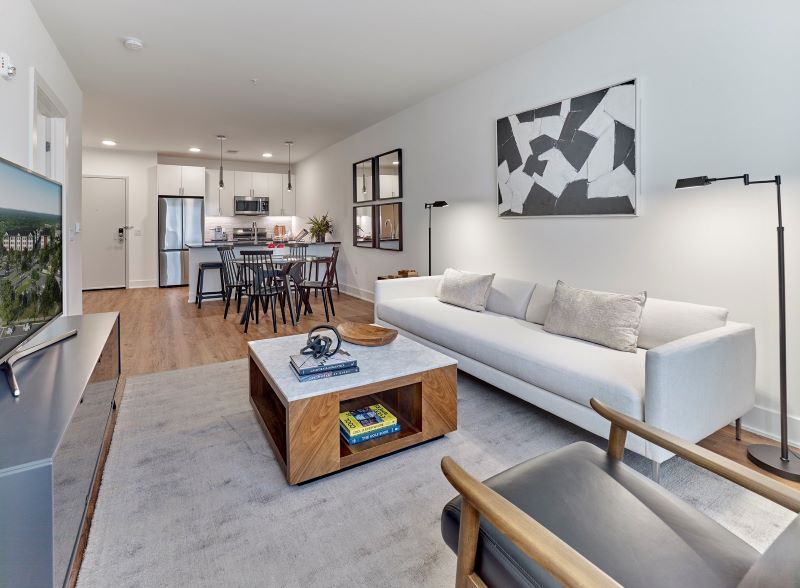The Nell, a 252-unit complex at 100 South Washington Ave. in Dunellen, is Prism Capital Partners’ newest multifamily property. — Courtesy: Prism
By Joshua Burd
The arrival of The Nell in downtown Dunellen last year was just the latest piece of Prism Capital Partners’ growing apartment portfolio in New Jersey. But the 252-unit property marked a key milestone for the developer, allowing it to reach its long-held goal of taking its residential property management in-house.
According to the firm, the luxury rental community at 100 South Washington Ave. gave it the scale it needed to justify both expanding its team and investing in new technology to support its overall housing platform. The move is already bearing fruit, providing real-time data that can boost performance, while reducing turnover and optimizing rental rates to ensure that the firm is enhancing the value of each property.

“I think the biggest thing we’ve learned is that having control of our own product, having control of our pricing, having control of our turns has helped us maintain our higher occupancies,” said Jon Hoff, a veteran industry executive and president of Prism Property Services, citing its impact on a portfolio that also includes properties in West Orange and Woodbridge.
Reaching the milestone is years in the making. Launched in 2002 by principals Gene Diaz and Ed Cohen, Prism’s roots are in suburban office buildings in Parsippany and other markets where it could add value through renovations and lease-up. It began to self-manage those properties within just a few years, hiring Hoff in 2007. But it was also around that time that the firm was expanding to multifamily development, seeking to diversify its business and protect against volatility in any single asset class.
That foray began with Parkway Lofts, an adaptive reuse of the historic former General Electric Co. building in Bloomfield, which opened in fall 2013 with 361 luxury apartments. It quickly became clear that residential property management was “a whole different thought process” from the commercial sector, Hoff said, pointing to the shorter leasing cycles at apartment buildings and the exponentially larger volume of tenants.
“The theory behind it is pretty much the same,” he said. “What really is much more complex is the amount of churn and turn that you have, the leasing and the numbers and making sure that you’re on top of that on a daily basis, because what you end up seeing is that you erode your (net operating income) and you kill your value at the end of the day. So for us, maintaining the rents, maintaining the value was the most critical thing that we were doing. But we didn’t understand it back then, not to the level that we understand it now.”

Prism took on management of Parkway Lofts, nonetheless, but would sell the property in fall 2014 to coincide with the end of an institutional partner’s fund life. When the firm in 2018 delivered its next project, the 334-unit Edison Lofts in West Orange, Hoff said the team knew it needed greater scale before making a full-fledged move into managing residential properties, opting instead to hire FirstService Residential.
It found that scale over the next few years as it delivered midrise projects such as Avenue & Green, a 232-unit property in downtown Woodbridge that opened in 2021, and The Nell in Dunellen, where the firm completed its final building last summer.
With more than 800 rentals under ownership and land holdings to support another 1,500 units, the Nutley-based firm last year took long-awaited steps such as investing in top-end software platforms such as Yardi and RealPage. It also built a new team led by Regional Manager Erin Faulkner, one of more than a half-dozen key hires, though it still uses The Marketing Directors during the initial lease-up of new projects.
Notably, those new additions joined a long-established commercial property management platform that covers assets such as ON3, Prism’s flagship mixed-use campus spanning 116 acres in Nutley and Clifton.
“We had enough of a mass to be able to bring a team together that could run the right platform,” Hoff said. “Before that, it was going to be too small, and you really needed to bring in a core group of people to be able to do this.”
He later added: “Getting into residential multifamily just changed our focus, and we needed the right type of tools to be able to do that.”

Prism executives note that the software, aside from giving them greater control over their assets, has provided crucial insights into upcoming vacancies and so-called lease trade-outs, a metric that measures an individual unit’s financial performance over time. The team also has access to real-time rent trends across the broader market, as well as artificial intelligence that can help guide pricing decisions.
“The people, the resources and making people happy is helping us with renewals,” Hoff said. “The software is allowing us to understand pricing and be able to push pricing as high as we can on a renewal — not to chase people away, but at the same time to also price to the market as we keep our occupancy up.”

Prism remains focused on growing its pipeline of ground-up multifamily projects, which figure to benefit from the systems that it has added over the past two years.
“We’re able to really compare metrics from deal to deal,” Diaz said. “And that’s a key component. So it gets us a very big head start on trying to understand expenses, load factors, cost factors,” in addition to providing live data on which unit types and floorplans are performing better.

Cohen added: “It really shortens the diligence period that we have to go through as well. We can analyze these things in a much swifter way than we’ve ever been able to do it.”
The tools are also critical as Prism looks to raise capital for new projects, Diaz said, helping it convey “the momentum in the marketplace” to prospective investors rather than be content with a current snapshot.
“Convincing them of that momentum is the hardest part, but being able to watch what’s happening on a daily basis … gives us that ability to do that and then step out in front of the market to where we think the market’s going to be,” he said, adding: “Things like that really allow us to adapt each project going forward to the market and see that we can enhance yield and then do better at the end of the day.”









